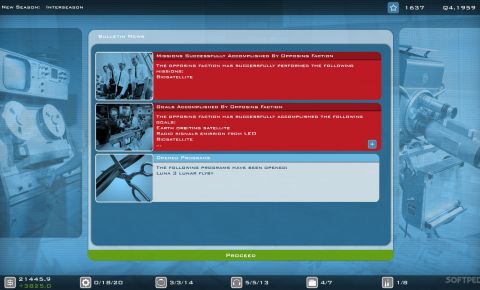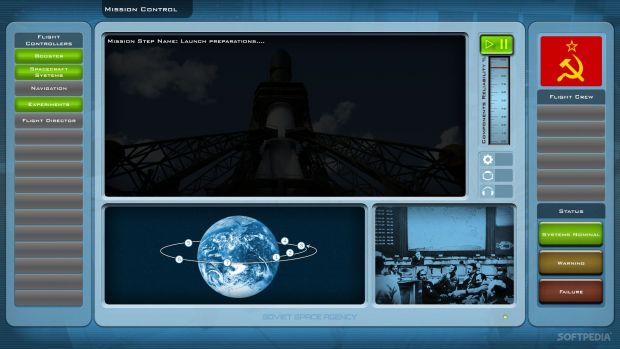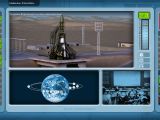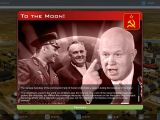Buzz Aldrin’s Space Program Manager might be the best and the worst way for a video game lover to learn about the space programs that both the United States and Communist Russia launched after World War II in order to explore space and reach the Moon and to make sure that their ballistic missiles were superior to the ones fielded by enemy forces.
The experience does have moments when it manages to evoke the complexity involved in designing even the simplest of space-bound payloads, but it often devolves into simple resource management, and the theme, generous as it is, does not manage to shine through.
Buzz Aldrin’s Space Program Manager allows gamers to choose between campaign and open-ended playtime, and both the American and the Russian programs can be controlled, each with historically accurate rockets and other technological advances.
At the same time, players can choose to control a Global Space Agency in a fictional campaign that allows them to explore more outlandish goals.
The core mechanics of Buzz Aldrin’s Space Program Manager involve a mix of long-term planning and careful season-to-season management of resources.
All campaigns have a long-term goal and some short-term achievements that need to be tackled, and space agencies only have so many resources to contribute.
There are a lot of projects to tackle and rockets to develop and build, and scientists, astronauts and other specialists need to be recruited in order to make small improvements to their design and increase their reliability.
Buildings need to be upgraded, the hiring process involves some limited choices, and there are clear goals for each mission that gamers need to target in the long term.
Once a project is advanced enough, it can be tested, but failure carries a price and Buzz Aldrin’s Space Program Manager asks gamers to carefully balance the risks and the rewards of sending material and men into space in order to test the limits of humanity’s reach.
The game can be exhilarating when attempting the first moon landing and a problem appears with one of the components, threatening the lives of astronauts, only to be fixed moments after that by the team.
Unfortunately, the game is very hands off when missions actually take place and the involved graphics fail to be immersive.
The best bits of Buzz Aldrin’s Space Program Manager are those that are directly linked to the real world space programs of the various nations, and there’s a lot to learn by simply taking a look at the various projects that can be developed and the process that leads from a simple idea to actual implementation and testing.
Failure is a constant companion and it’s heartbreaking on some levels to see astronauts dying in a failed space capsule mission, but in a nice twist, theoretical research can only do so much for a project and actual launches and flights are required, with all their associated risks.
It’s all too easy to overextend in Buzz Aldrin’s Space Program Manager, and a deficit is a sure way to fail in the game. However, I have found that the best approach is to focus on just two projects early on and then expand slowly, trying to achieve goals at a solid pace, while also adding more scientists and other assets.
Another disappointment is the limited link between the activity of the space agency and the rest of the world.
I felt trapped in a tech bubble, with only limited interaction with the public, while in the real world the space program was a major source of news and generated pride among the population of the competing nations.
But when I manage to land on the moon or complete particularly tricky long-term missions, the game can also make me feel like a hero, even if chance played a big part and I basically only fine-tuned the way the organization prepared the mission.
On the one hand, Buzz Aldrin’s Space Program Manager is not a graphics powerhouse, and on the other, it could have used more abstraction.
It’s easy for players to get the info they need during the campaign, but watching missions unfold quickly becomes boring and the entire interface could have used an infusion of color.
Buzz Aldrin’s Space Program Manager can be played in multiplayer via an e-mail-based system, but gamers need to deal with the hassle of setting up and then using an alternate system linked to the publisher of the game, although Steam is more than capable of handling such elements.
The Good
- Focus on space exploration
- Tension-filled moments
- Interesting theme
The Bad
- Limited context
- Simple mechanics
Conclusion
After all, the United States is now just returning to orbit with the Orion after a long absence and there’s talk about landing on Mars in our lifetime, while also preparing even more ambitious missions to the outer reaches of the Solar System and comets.
The development team chose to play it safe and created a game that aims to show the process of space exploration and the world that supporting teams need to put in place so that astronauts can get into space and wonder at the beauty of Earth.
Nevertheless, the game can be enjoyable for someone who has a passing interest in the exploration of space and in management, but it requires more tutorials, better information delivery, and more depth in order to appeal to a wider audience.
 14 DAY TRIAL //
14 DAY TRIAL // 






















